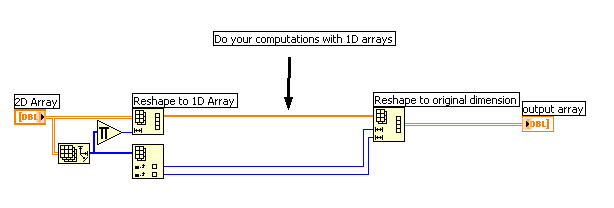- Subscribe to RSS Feed
- Mark Topic as New
- Mark Topic as Read
- Float this Topic for Current User
- Bookmark
- Subscribe
- Mute
- Printer Friendly Page
- « Previous
- Next »
Obtaining equations with 3D graph
06-13-2005 07:21 PM
- Mark as New
- Bookmark
- Subscribe
- Mute
- Subscribe to RSS Feed
- Permalink
- Report to a Moderator
@Honeywell wrote:
Still having a hard time coming up with a VI that gives me 2D polynomial equation. 😞
That seems to be easy. One possibility is attached (LabVIEW 6.1) 🙂
Inputs: x, y, coefficients[]
Output: Z
06-14-2005 11:22 AM
- Mark as New
- Bookmark
- Subscribe
- Mute
- Subscribe to RSS Feed
- Permalink
- Report to a Moderator
Just took a look at that last VI but I don't think that's what I want.
What I need the program to do...
Input 3 matrices (X, Y, Z) and find the 2D polynomial equation (z= a + bx + cy + dx^2 + ey^2 + ....)
Right now that program takes X and Y and just inputs them into the polynomial equation.
Sorry if I didn't make it clear earlier.
06-14-2005 12:48 PM
- Mark as New
- Bookmark
- Subscribe
- Mute
- Subscribe to RSS Feed
- Permalink
- Report to a Moderator
http://sine.ni.com/apps/we/niepd_web_display.display_epd4?p_guid=B123AE0CBB3C111EE034080020E74861&p_node=DZ53022&p_source=external
06-14-2005 01:50 PM
- Mark as New
- Bookmark
- Subscribe
- Mute
- Subscribe to RSS Feed
- Permalink
- Report to a Moderator
Be aware that it incorporates all xy mixed terms but it should be easy to adapt.
(It goes along the alternative idea mentioned (General LS fit) in my last paragraph here. I was just starting to make my own example, but this should get you started).
06-14-2005 01:55 PM
- Mark as New
- Bookmark
- Subscribe
- Mute
- Subscribe to RSS Feed
- Permalink
- Report to a Moderator
Just took a look at the VI and that looks like what I have in mind. Except now I need it in 2D matrice not 1D. I'll play around with it.
06-14-2005 02:00 PM
- Mark as New
- Bookmark
- Subscribe
- Mute
- Subscribe to RSS Feed
- Permalink
- Report to a Moderator
Just took a look at the VI. It looks similar to what I want to do except I need the arrays in 2D.
The program seems to calculate the cross terms as well. Don't need that.
I'll try and see what I can do with this (probably not too far though 😞 )
06-14-2005 02:11 PM - edited 06-14-2005 02:11 PM
- Mark as New
- Bookmark
- Subscribe
- Mute
- Subscribe to RSS Feed
- Permalink
- Report to a Moderator
You can reshape the 2D arrays to a 1D array for fitting, then reshape he Z' result back to the original dimension at the end. Reshaping an aray is computationally very cheap, because it just reinterprets the array without touching it in memory (see the online help on "reshape array").

After all, you simply need to operate on a collection of (x,y,z) points, it does not matter how they are arranged. The result will be the same if I uderstand your problem correctly.
Message Edited by altenbach on 06-14-2005 12:12 PM
06-14-2005 04:04 PM
- Mark as New
- Bookmark
- Subscribe
- Mute
- Subscribe to RSS Feed
- Permalink
- Report to a Moderator
If I do that on Using3DPolyFitandEvaluation would that give me the correct polynomial constants? I'm having a bit of difficulty following the math here. :S
06-14-2005 04:11 PM - edited 06-14-2005 04:11 PM
- Mark as New
- Bookmark
- Subscribe
- Mute
- Subscribe to RSS Feed
- Permalink
- Report to a Moderator
Inputs are 2D arrays for X and Y, an arbitrary odd number of coefficients (determining the poly order!) and gaussian noise.
This simulates noisy Z data (Here you would substitute your own Z data!) which is then reshaped and input into the General LS fit.
The H matrix is calculated from the X and Y arrays based on the number of coefficients.
Just run it with the default inputs for a demo.
I added some annotations, see if it makes sense to you. Good luck! 🙂
Message Edited by altenbach on 06-14-2005 02:12 PM
06-16-2005 10:02 AM
- Mark as New
- Bookmark
- Subscribe
- Mute
- Subscribe to RSS Feed
- Permalink
- Report to a Moderator
I thought I'd quickly rewrite that part for cleaner and more efficent code, works the same but is probably faster. 🙂
See if it makes sense. Enjoy!
- « Previous
- Next »
